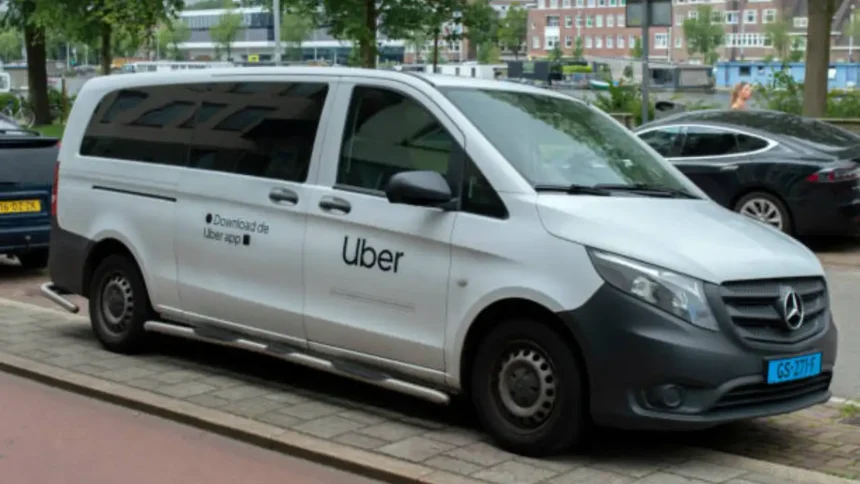Mumbai Uber Shuttle Service Shut Down as Maharashtra Cracks Down on Unlicensed Bus Operations
In the bustling city of Mumbai, where every commute is a race against time and space, the introduction of Uber’s shuttle service was hailed as a timely innovation. Designed as a middle-ground solution between overcrowded trains and expensive taxis, the Uber Shuttle aimed to redefine public mobility for the urban middle class. Yet, in a dramatic turn of events, the initiative has been abruptly halted. The Maharashtra government has launched a statewide crackdown on unlicensed private bus services, placing Uber’s shuttle operations under regulatory scrutiny and eventually forcing the service off the road.
The decision to suspend Uber’s shuttle service is more than a policy action—it represents a larger debate unfolding across Indian cities. On one hand, technology-driven mobility services promise flexibility, efficiency, and comfort. On the other, the regulatory framework governing public transport remains rooted in legacy laws, often ill-equipped to accommodate new-age models. This collision between innovation and legislation raises critical questions: Can governments adapt fast enough? Should global tech companies operate in grey regulatory zones? And what happens to commuters caught in the crossfire?
This long-form investigation will explore every dimension of this unfolding story. In Part 1, we trace the origins of Uber Shuttle in Mumbai, the promise it held for the city’s daily commuters, and how it evolved into a point of contention with state transport authorities.
The Uber Shuttle Concept: A Middle Path for Urban Commuters
Launched in several metro cities globally, Uber Shuttle is a shared ride service that operates via mini-buses or vans. It functions through a pre-scheduled route model—commuters can book seats on specific routes and times through the Uber app, just like booking a regular cab. The advantage is obvious: lower costs than taxis, more comfort than trains, and more predictability than autos or buses.
In Mumbai, the pilot rollout focused on corporate-heavy corridors like BKC (Bandra-Kurla Complex), Powai, Andheri, Lower Parel, and parts of Navi Mumbai. These areas are notorious for peak-hour congestion and inconsistent public transport options. The Uber Shuttle, with air-conditioned seating, digital booking, and real-time tracking, offered a compelling alternative to thousands of working professionals.
From a user experience standpoint, the model had several advantages:
- Pre-booked seats ensured no overcrowding
- Cashless payment via app integrated wallets
- Tracking features added safety and transparency
- Fixed routes and stops meant less unpredictability than autorickshaws or local buses
- Centralized feedback system through the Uber app enabled quality control
The initial reception was promising. Daily ridership grew steadily, and the company planned route expansions and partnerships with office parks. For a city perpetually on the edge of traffic paralysis, the shuttle was seen by many as Mumbai’s first true step toward intelligent, tech-led mass mobility.
Early Challenges: The Grey Zone of Regulation
Despite its digital sheen, Uber Shuttle entered the Mumbai ecosystem through a legal grey area. The vehicles used were typically tourist permit buses, registered under private operators who were affiliated with Uber via lease or aggregator agreements. While this operational model was common in other countries, in India it ran afoul of certain provisions under the Motor Vehicles Act, 1988 and rules framed by state transport authorities.
At the heart of the issue was license classification. Uber Shuttle was not registered as a state-recognized public transport service, nor did it operate under stage carriage permits required for buses plying fixed routes with fare-paying passengers. Instead, the service was structured as a private contract arrangement between Uber and bus owners, thereby bypassing conventional checks, insurance norms, and fare control mechanisms.
From a legal standpoint, this made Uber Shuttle vulnerable to action by the Regional Transport Office (RTO) and state regulatory authorities, particularly under sections related to:
- Unauthorized stage carriage operations
- Violation of passenger capacity norms
- Failure to disclose route approvals
- Operating without state fare and time-table authorization
What began as a commuter-friendly innovation quickly became a thorn in the side of bureaucratic frameworks that were not designed to handle digitally-managed transport models.
Government’s Crackdown: Citing Safety and Compliance
The turning point came when the Maharashtra government initiated a transport compliance audit across major districts, including Mumbai, Thane, and Pune. As part of the audit, RTO officials began inspecting private shuttle operations. Several Uber-affiliated shuttle vehicles were found operating without stage carriage permits, in violation of both state and central transport rules.
Citing passenger safety concerns, improper documentation, and potential risks posed by unlicensed and unmonitored operators, the state ordered an immediate halt to Uber’s shuttle operations. Notices were issued to operators, and buses found violating norms were impounded. According to transport department sources, over 30 buses were seized across Mumbai in the crackdown’s first phase.
A senior transport official stated, “Any service that picks up passengers for a fare along fixed routes requires a stage carriage license. Uber’s shuttle model failed to meet these legal requirements.”
The move was not merely a bureaucratic exercise. Officials argued that unregulated operators pose risks related to insurance liabilities, driver vetting, fare inflation, and absence of grievance redressal mechanisms under state oversight.
Uber’s Response: Innovation or Overreach?
Uber India, in its initial response, maintained that the shuttle service was compliant with prevailing laws and operated under contract carriage norms. The company emphasized that all vehicles were commercially registered and drivers underwent background checks.
In a statement issued after the crackdown, Uber said:
“We are committed to working with the authorities to ensure compliance and believe in offering safe, reliable, and affordable mobility options to the people of Mumbai. Our shuttle service is designed to reduce congestion and support sustainable urban transport.”
Behind the scenes, however, industry experts believe Uber miscalculated the regulatory rigidity in Indian states—particularly Maharashtra, where the transport unions and traditional public operators hold strong influence. By operating outside the conventional route approval process, Uber may have unintentionally triggered a defensive reaction from entrenched stakeholders, including local bus unions and government-run transport bodies like BEST.
Public Reaction: Commuters Caught in the Middle
As the crackdown took hold, thousands of daily commuters were left stranded. The Uber Shuttle had become a reliable daily commute solution for many professionals—particularly those in areas underserved by local train lines or BEST buses.
Several users took to social media to express frustration:
“This was the only safe and comfortable way to get from Powai to BKC. Now we’re back to auto rickshaws and surge pricing taxis.”
“How can a digital-first state like Maharashtra stop a tech-based shuttle but allow overcrowded illegal autos to run freely?”
The sentiment was clear: commuters valued convenience and tech-driven service more than the bureaucratic nuances of permits and classifications. Many called for reforms in transport laws to accommodate app-based operators and prevent blanket bans that disrupt citizen mobility.
A Symptom of a Larger Crisis
The Uber Shuttle shutdown in Mumbai is not just about one company or one city—it symbolizes the struggle between emerging mobility models and India’s legacy transport laws. At a time when urban populations are exploding and sustainability demands smart transport, the gap between regulation and innovation becomes increasingly untenable.
As Maharashtra tightens enforcement and other states watch closely, the question remains: Can India build a legal framework that protects public interest while still encouraging innovation?
The abrupt halt of Uber’s shuttle service in Mumbai has laid bare an uncomfortable truth—India’s transport laws, designed in an analog era, are ill-equipped to regulate digital-age mobility solutions. As the state of Maharashtra intensifies its crackdown on unlicensed private buses, it becomes increasingly evident that the problem is not just non-compliance by operators. It’s also a failure of the regulatory system to evolve in tandem with innovation.
In this part, we trace the history of bus licensing laws in India, examine their structural limitations, and analyze why the current regulatory framework finds itself unable to accommodate emerging models like Uber Shuttle. We also explore what it would take to modernize transport policy in a country that is both a booming mobility market and a lagging regulatory state.
The Foundation: India’s Motor Vehicles Act, 1988
At the heart of India’s transport regulatory system is the Motor Vehicles Act, 1988, a central legislation that governs all motor vehicle-related operations, including licensing, permits, registration, and traffic regulations. The law broadly classifies transport vehicles into:
- Stage carriages – vehicles permitted to carry passengers along a fixed route, with designated stops, such as city buses.
- Contract carriages – vehicles hired for a particular trip or period, like taxis and private buses used for weddings or corporate events.
Under this framework, buses operating scheduled routes with fare-paying passengers are required to hold stage carriage permits, which involve approval of routes, fare slabs, and operational hours by the State Transport Authority (STA). Conversely, contract carriages are not allowed to operate scheduled or shared rides for public passengers.
This distinction made sense in the 1980s and 90s. But in today’s context, app-based ride-sharing models don’t fit neatly into either category. They offer a hybrid service—scheduled, shared, but tech-managed. The Uber Shuttle, for example, operates like a private bus (contract carriage) but behaves like a mini-public transport service (stage carriage). This ambiguity has left it in regulatory limbo.
The Licensing Bottleneck: Limited Permits, Slow Reform
One of the most critical pain points is the limited number of stage carriage permits available in Indian states. These permits are tightly controlled, often capped due to legacy congestion concerns, and dominated by government transport bodies or long-established private operators.
In Maharashtra, BEST (Brihanmumbai Electric Supply and Transport) and MSRTC (Maharashtra State Road Transport Corporation) hold a lion’s share of these permits. This makes it incredibly difficult for new-age mobility operators to acquire the legal backing they need to run bus services on fixed routes.
The reasons are multifaceted:
- Bureaucratic delays in permit issuance and renewals.
- Political influence over transport unions and regional operators.
- Quota-based allocation that often excludes digital-first companies.
- Lack of digital route planning or smart scheduling systems within STAs.
As a result, startups and mobility innovators either operate under contract carriage licenses—exploiting interpretative loopholes—or tie up with private fleet owners who may not comply fully with licensing requirements. This “workaround” is what led to the Uber Shuttle’s eventual clash with the Maharashtra government.
An Uneven Playing Field: Private vs Public Operators
Public transport authorities have often argued that allowing app-based private operators to function without stage carriage permits creates an unfair market imbalance. While public bodies are bound by fare caps, staffing rules, union demands, and fuel procurement limits, app operators enjoy pricing flexibility, demand-based routing, and app-based tracking—all without regulatory burden.
This resentment has led to active resistance from transport unions, who argue that companies like Uber, if left unchecked, will cannibalize public transport ridership and destabilize the fare equilibrium.
In Mumbai, this resistance was visible. Several union leaders raised objections against Uber’s shuttle service, citing issues such as:
- Undercutting government bus fares
- Hiring of untrained or privately contracted drivers
- Lack of compliance with vehicle maintenance norms
- No contribution to public sector pension or employment systems
The government, too, finds itself walking a political tightrope—balancing the need for mobility innovation with the voter base of unionized transport workers.
Technology Outpacing Policy
In other global cities—London, Singapore, Dubai—urban transport regulators have responded to app-based models by introducing dedicated digital mobility frameworks. These include:
- Mobility-as-a-Service (MaaS) licensing
- Digital aggregator permits
- Dynamic pricing oversight tools
- Real-time data sharing mandates
In contrast, Indian transport policy remains paper-based, route-fixed, and analog in enforcement. Even though the Motor Vehicles (Amendment) Act, 2019 introduced the idea of aggregator licenses, its implementation remains patchy across states. Maharashtra, for instance, has yet to develop a comprehensive policy for shuttle-based app aggregators, leaving operators like Uber Shuttle exposed to blanket bans.
This policy vacuum is not just stifling innovation—it’s pushing startups to operate in legal grey zones, increasing risk for both commuters and investors.
Judicial Interpretation: Courts Caught in the Middle
The conflict between digital innovation and old transport laws has increasingly reached the courts. In several cases, state transport departments have taken app-based operators to court, accusing them of violating licensing norms.
However, courts have often responded with ambiguous or delayed rulings, citing the need for legislative clarity. In one notable 2016 case, the Karnataka High Court ruled that ride-sharing services must operate within the legal definition of a contract carriage, not a stage carriage—creating a precedent that was later challenged in other jurisdictions.
Legal experts argue that unless Parliament or State Assemblies amend the law to reflect 21st-century realities, courts will continue to be limited in their ability to provide clarity.
The Need for a National Mobility Framework
India urgently needs a National Urban Mobility Framework that:
- Recognizes digital aggregators as a distinct category
- Allows for hybrid licensing models—combining elements of contract and stage carriage
- Mandates public data sharing for planning and transparency
- Sets safety and insurance benchmarks specific to tech-based operators
- Creates dispute resolution forums for operator-government conflicts
Such a framework would not only legitimize models like Uber Shuttle, Rapido Bus, and others—it would also allow governments to plan urban mobility holistically, using real-time data and demand-driven service provisioning.
A System Struggling to Modernize
The Uber Shuttle ban in Mumbai is not just about permits—it’s about an outdated system trying to regulate a modern world without the right tools. India’s bus licensing laws, created for a different era, are now standing in the way of urban transport progress.
Unless states embrace regulatory reform, India will continue to face a frustrating paradox: digital tools powerful enough to ease congestion and enhance mobility, strangled by paperwork too rigid to evolve.
The termination of Uber’s shuttle service in Mumbai has rippled far beyond policy circles and transport offices. It has struck at the core of everyday life for thousands of officegoers, students, and professionals who had come to rely on the service as a dependable, tech-savvy, and comfortable alternative to the chaos of Mumbai’s traditional transport network.
In this part, we step out of the boardrooms and courtrooms and into the lived experiences of those most affected: the commuters. Through interviews, data, social media sentiment, and commuter-led petitions, this section explores the human dimension of the crackdown—what people are feeling, how they are adjusting, and what their expectations are from government and private players going forward.
The Morning After: Daily Disruption Begins
For many Mumbaikars, the first morning without the Uber Shuttle brought back memories of long waits, missed connections, and overcrowded commutes. For the last several months, thousands had begun to weave the shuttle service into their morning routines. Most users pre-booked seats through the Uber app, often selecting specific shuttles that matched their office hours.
That predictability vanished overnight.
“The 8:10 AM shuttle from Goregaon to BKC was always on time. Today I had to wait 22 minutes for an auto that refused to go halfway,” said Rakesh Pillai, an IT consultant.
“It was the only air-conditioned ride that didn’t cost a fortune,” said Shraddha Vyas, a marketing executive from Sion. “Now I’m back to crowded buses and surge-priced cabs.”
While BEST and local trains still form the backbone of Mumbai’s transport grid, Uber Shuttle had become the mobility solution for the in-between class—those who didn’t want to rely on uncertain autos but couldn’t afford daily cab rides either. It catered to the aspirational professional class—millennials, women, freelancers, and middle-management employees.
The sudden shutdown meant this demographic had to rework their entire commute—with increased stress, delays, and costs.
The Safety Angle: Women Hit Hardest
Perhaps the most poignant consequence of the service suspension is felt by women commuters, many of whom chose Uber Shuttle specifically for its safe, app-tracked, and predictable environment.
Mumbai, though safer than many Indian cities, still poses challenges for female commuters—particularly during early or late office hours. The shuttle, with its digital seat bookings, route tracking, and vetted drivers, offered a reliable way to travel with peace of mind.
“The shared auto system is too random. Cabs are too expensive. The shuttle was perfect,” said Meher Shaikh, a 27-year-old analyst who used the service between Andheri East and Lower Parel.
The service also offered comfort: clean interiors, AC seating, and a relatively calm ride. Women professionals who work in finance, tech, and media offices in BKC and Lower Parel—areas where shuttle routes were concentrated—found that their entire daily rhythm has been disrupted.
Safety is not just about crime. It’s also about predictability, familiarity, and transparency. In a city where transport is often chaotic, Uber Shuttle provided a small but significant assurance—a known driver, a digital trail, and a sense of order.
Office Parks and Startups: Back to Private Vans
Many offices in areas like Powai, BKC, Vikhroli, and Navi Mumbai had begun encouraging employees to use Uber Shuttle, even offering stipends or passes for the service. Startups and smaller firms especially saw it as a cost-effective transport allowance.
After the shutdown, several companies were forced to revert to private van aggregators, many of whom operate with minimal digital oversight, manual tracking, and poor service quality.
“We had just integrated Uber Shuttle into our HR platform as a part of our sustainable mobility policy,” said Amit Rao, HR head at a fintech company in Powai. “Now we’re looking for alternatives, but none offer real-time tracking or route flexibility.”
Others raised concerns about accountability. Private vans often have:
- No cancellation system
- No uniform pricing
- No route optimization
- No emergency contact protocols
In contrast, Uber Shuttle, like many app-based models, offered centralized complaint resolution, app-based customer support, and transparency in fare and ETA. Losing that ecosystem has, in effect, set many companies back by several years in their employee mobility planning.
Social Media Backlash: Hashtag Activism Emerges
Almost immediately after the shutdown, social media erupted. On X (formerly Twitter), hashtags like #BringBackUberShuttle, #ShuttleBanHurts, and #SmartCommuteForMumbai began trending locally. Users tagged not only Uber India but also Maharashtra’s Transport Ministry, demanding clarity and reform.
The posts expressed a range of emotions:
- Frustration at the sudden withdrawal
- Confusion over the legal grounds
- Suggestions for regulatory reform
- Comparisons with other cities like Delhi, Bengaluru, and Hyderabad where shuttle services continue under alternate permits
“Dear @mybmc & @MahaTransport, shutting down Uber Shuttle is NOT progress. It’s punishing people who just want to commute in peace.”
— posted by a user from Thane
“India wants Digital India, but bans digital buses? What kind of development is this?”
— another commuter from Chembur
The feedback was not entirely one-sided. A smaller set of users and unions argued in favor of the ban, calling Uber’s operation legally non-compliant and unfairly competitive. However, the overwhelming sentiment—especially among the working class urban middle—was that the service had solved a real problem and its removal had only worsened commute challenges.
Citizen Petitions and Policy Advocacy
A change.org petition titled “Reinstate Uber Shuttle in Mumbai with Proper Regulation” crossed 40,000 signatures within three days. Authored by a group of Mumbai-based tech professionals, it demanded that the government:
- Develop a hybrid permit model for app-based shuttles
- Introduce fast-track licensing for shuttle aggregators
- Implement commuter safety norms via tech-backed compliance tools
- Allow temporary route continuation during policy transition
Transport policy experts from IIT Bombay and Mumbai University have also weighed in, suggesting that rather than banning digital models, the state should partner with them to reduce congestion and pollution. In fact, shuttle services, when aggregated and optimized, can take more private cars off the road—a key SDG (Sustainable Development Goal) for urban India.
Return of the Black Market Vans?
A less spoken but equally troubling fallout is the re-emergence of unregulated private vans—the very kind the state wanted to crack down on. With Uber Shuttle gone, some commuters are turning to neighborhood WhatsApp groups and informal van aggregators who run unlicensed vehicles with cash payments and no digital record.
Ironically, these services are far more dangerous than what Uber was offering—yet they now face less scrutiny. This paradox has led many to ask: Has the crackdown targeted the wrong players?
The Real Stakeholders Left Behind
Commuters are the ultimate stakeholders in any transport ecosystem. They bear the cost of poor planning, benefit from smart policies, and suffer when regulation fails to adapt. The Uber Shuttle shutdown has revealed a serious mismatch between commuter needs and government readiness to support innovation.
This is not just about legality—it’s about livelihood, dignity, and daily survival in a city where every minute on the road counts.
Also Read : Why Viral Fevers, Dengue & Typhoid Cases Surge by Over 60% During Rainy Season








